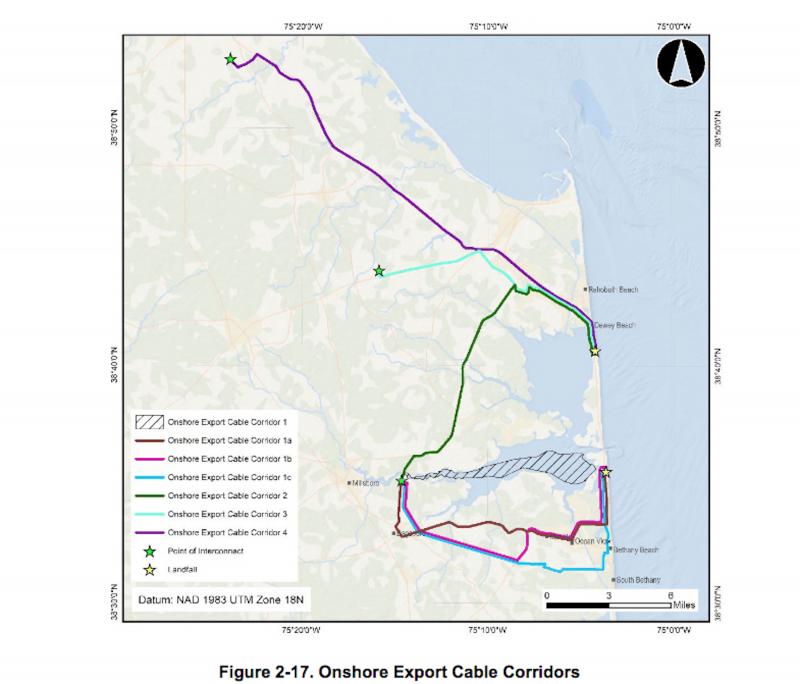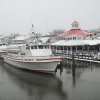US Wind proposes wind farm landfall under 3R’s Beach
Almost three years ago, Danish power company Ørsted introduced a proposal that would have paved the way for its Skipjack Wind project off Delaware’s coast to make landfall in Fenwick Island State Park. Ultimately, after much public scrutiny, that proposal was pulled off the table.
Now, US Wind, a Maryland-based company, is proposing to make landfall for its wind farm project off Ocean City, Md., at 3R’s Beach in Delaware Seashore State Park.
The information became available as part of the company’s construction and operations plan under review by the Bureau of Ocean Energy Management. BOEM released the plan for public consumption June 8.
According to the plan, US Wind’s preferred landfall location is 3R’s Beach, but there is also an option for landfall at Towers Road Beach. In an email June 15, Mike Dunmyer, US Wind Delaware development manager, said 3R’s is the preferred landfall location because it creates the least amount of disruption offshore, onshore and in the local area.
The preferred option calls for running cable under Indian River Bay from 3R’s to the Delmarva Power & Light’s substation adjacent to the Indian River power plant in Dagsboro. The plan says an expansion of the substation of up to two acres is expected to accommodate the new capacity and required transformers, breakers, switch and control gear. The plan also calls for a transition vault to be constructed within the parking lot of 3R’s Beach.
US Wind has twice been awarded offshore wind renewable energy certificates from the Maryland Public Service Commission – in 2017 for MarWin, which is expected to generate 300 MW, then again in 2021 for Momentum Wind in the same federal lease area, which is expected to generate about 808 MW. To accommodate the 1,100 MW of energy, the plan calls for up to four cables running under the dune at 3R’s Beach. Dunmyer said each cable can carry about 400 MW of energy, which means multiple cables are needed.
The four cables run roughly parallel as they travel from the wind farm to the point of interconnection to the grid, said Dunmyer. Offshore, he explained, the cables will be spaced apart roughly three times the water depth, but when they pass under the dune, they’ll be about 30 feet apart.
Once landfall is made, the plan has options for cables to be on land in public rights of way, but the preferred method for reaching the Indian River substation would be to bury the cables under the Indian River Bay. Dunmyer said there would be a target depth between 3 and 10 feet in the bay, but the cables would be deeper in areas where the bottom is more dynamic to ensure they remain buried.
Dunmyer said US Wind would use horizontal directional drilling to put the cables at a depth of about 60 feet as they cross under the dunes and 30 to 40 feet beneath the wetlands along the east and west coasts of the bay.
Landfall may be proposed for Delaware, but the plan calls for US Wind to put its operations and management facility in Ocean City. Dunmyer said Ocean City is the closest coastal town to the lease area, and it also has port facilities that enable the development of a marine coordination center.
As part of its landfall proposal in late 2019, Ørsted offered to make roughly $20 million in improvements to Fenwick Island State Park.
It’s not clear if there’s a similar offer from US Wind.
“US Wind is looking forward to being a part of the Delaware community for years to come,” said Dunmyer. “As part of being a good neighbor, we’re excited to hold discussions with all relevant stakeholders to explore opportunities to benefit the community.”
At this point, the Delaware Department of Natural Resources and Environmental Control hasn’t decided if US Wind will be allowed to make landfall in Delaware Seashore State Park.
In an email June 15, Michael Globetti, DNREC spokesman, said the agency is aware of US Wind’s interest in the park areas as possible locations to bring transmission lines ashore, but no determination has been made to allow the company the use of the state parks.
Globetti said last month DNREC announced US Wind is updating information collected in the Indian River Bay in 2016-17, and is also conducting geotechnical work in the Atlantic Ocean and at some land-based locations as it explores various alternatives. At that time, he said, DNREC noted that any project of this scope requires an extensive regulatory process, as well as considerable public input, and then an agreement with the state if there was interest in state lands.
“None of that has occurred,” said Globetti.
Three public hearings scheduled for end of June
As part of releasing US Wind’s construction and operations plan, BOEM has also issued a notice of intent to prepare an environmental impact statement for the offshore project.
The notice initiates a 30-day public comment period that ends Friday, July 8. During the public comment period, BOEM will be hosting three virtual scoping meetings where members of the public can learn more about the plan, ask questions and provide oral testimony.
The virtual meetings will be held at 5 p.m., Tuesday, June 21 and Thursday, June 23, and at 1 p.m., Monday, June 27.
Dunmyer said the presentations will be the same across all three meetings. The intent is to provide ample opportunity for all interested parties to participate, he said.
According to the BOEM website, following the comment period, BOEM will review the comments received to identify issues and potential alternatives. For more information, go to boem.gov, scroll about halfway down the page and click on the link under the BOEM Highlights section.
Chris Flood has been working for the Cape Gazette since early 2014. He currently covers Rehoboth Beach and Henlopen Acres, but has also covered Dewey Beach and the state government. He covers environmental stories, business stories and random stories on subjects he finds interesting, and he also writes a column called Choppin’ Wood that runs every other week. He’s a graduate of the University of Maine and the Landing School of Boat Building & Design.

























































